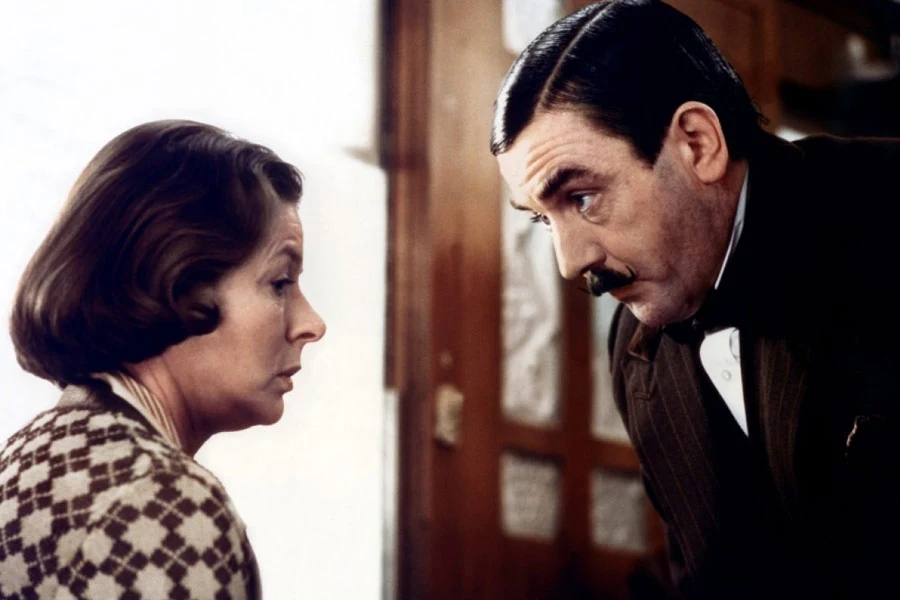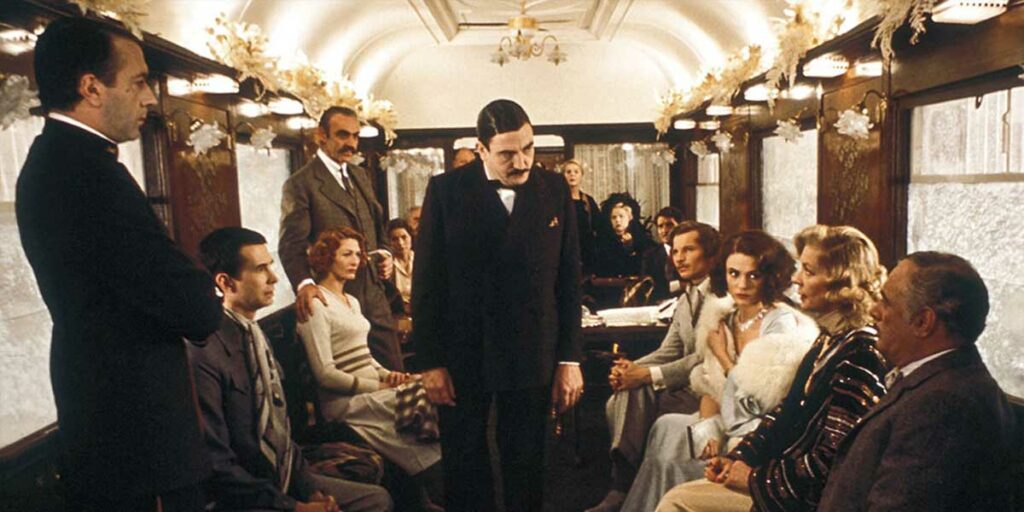Murder on the Orient Express (1974) is a good, old-school adaptation with a highly entertaining lead performance, even if it sags with its mechanical storytelling.
Muder on the Orient Express is a 1974 adaptation of Agatha Christie’s classic mystery novel of the same name, directed by Sidney Lumet and starring Albert Finney as the iconic detective Hercule Poirot. When traveling from Istanbul to London on the titular Orient Express, Poirot finds himself in the company of many colorful characters, played by an all-star cast including Ingrid Bergman, Anthony Perkins, Lauren Bacall, and Sean Connery. When American businessman Samuel Ratchett (Richard Widmark) is found murdered in his bed one morning, Poirot takes it upon himself to investigate these passengers and find out who the killer is, learning more about the true identity of Ratchett and his connections to others on board the train.
I know the original Christie novel and have seen the 2017 Kenneth Branagh film adaptation, so this is far from my first experience with this story. I do, however, recognize this as being the first big-screen adaptation, so I kept that in mind as I watched what Sidney Lumet – who’s made some great films including the classics 12 Angry Men, Dog Day Afternoon, and the criminally overlooked Long Day’s Journey Into Night – would do as the first film director to bring this story to life. Right away, the biggest standout that sets this version apart from others is Finney as Poirot. Is it fitting to say he steals the show if the show was already supposed to be about him? Because he is far and away the biggest standout in this stacked cast, as he should be.
Poirot is portrayed as the comically eccentric, buffoonish yet hyper-intelligent detective he always was, with Finney bringing an outlandishly cynical presence to him. Before the murder occurs, Poirot seems almost indifferent and bored by the world around him, having a bit of a superiority complex and not being particularly sociable or sensitive. Once the murder does occur, it injects life into him as he interrogates and investigates, almost like he gets some bizarre thrill from looking into such a gruesome act. Finney’s voice and way of carrying himself always stop just short of being grating, making his character always fun to watch.
The rest of the cast bring as much presence and personality to their characters as they can with the material they need to work with. The standouts for me are Bergman and Perkins, both of whose characters clearly have something to hide but also seem likeable enough where you hope neither one of them is the killer. Widmark isn’t on screen for too long for obvious reasons, but he leaves his mark as someone who feels just a hint threatening, like you can’t quite trust him but you can’t place why. And sure enough, you later find out that these instincts are very much validated as you learn who he really is and what he’s done. Y
ou learn this largely through the many rounds of questioning Poirot has with each of the suspects. Most of the middle portion of Murder on the Orient Express consists of these scenes, which is something that both this film and the Branagh version struggle to make work. Having characters tell us their entire backgrounds and feelings almost solely through these back-and-forth dialogues is really hard to make engaging, and while Lumet and the actors are skilled enough to keep you from getting outright bored, this trapping persists to some degree.

This issue extends to the ultimate reveal of who killed Ratchett and why. The final twenty-odd minutes are essentially just Poirot walking back and forth and explaining the entire mystery to everyone. This is made watchable by Finney’s scenery-chewing performance, but it still adds to the mechanical nature that this version of Murder on the Orient Express suffers from. I’ll admit, though, that it may hit harder for those who don’t know the answers ahead of time. My favorite part of Murder on the Orient Express in any iteration is how it subverts the expectations you’d likely have for a murder mystery like this. The answers aren’t simplistic or cut-and-dry, taking the presumptions of Poirot and the audience and using them against us. These are my favorite kinds of murder mysteries, where it’s not as easy as there being just a killer and a motive. You also see how much pain and suffering has been spread to so many people in so many different ways because of Ratchett, further blurring the lines of what’s excusable and what’s not. Having all of this slowly dawn on an unsuspecting viewer somewhat justifies the drawn-out nature of the third-act reveals.
Murder on the Orient Express can also be a challenge to get through because of the sheer claustrophobia that comes from being stuck on this train through most of the movie. This is not some lush, extravagant ride these people are on. The halls are narrow and the rooms are small. The shots are tight and the camera very subtly shakes as the train is in motion. The lighting is either minimal or an almost ghostly white as it comes in from the snow-riddled outdoors. All of this adds to the discomfort of everyone being trapped in one location after a murder has taken place, a discomfort that persists even if you know everything that happened. I love the shots of the Orient Express itself from outside as well.
The train really looks like a relic of the past, further immersing you in this old-fashioned tale as it rides through the lovely scenery. Lumet, as usual, goes for a very straightforward visual style that’s fitting for this story, but he includes enough of these touches to keep the film from looking bland. He also shows how good he is at blocking a huge cast of characters, pointing the camera where it’s needed to keep the right people in focus while still letting the frame illustrate the scope and dynamics of everyone else in the room.
Overall, I like this version of Murder on the Orient Express. It tells its classic story reasonably well, anchored by a loveable lead performance and a rustic old-school feel. It’s just hard to get remarkably invested with how procedural and non-dynamic the storytelling is, something that also makes the film feel considerably long. In all honesty, I actually like the Branagh version a bit more, mainly because of how he portrays Poirot. While Finney’s version is fun for his eccentricity, Branagh’s is not only just as fun with his dry, stylish wit, but he brings much more emotional depth to the character, especially as he pieces together the truth. But whichever version you like more, I’m just glad that they manage to follow largely the same beats while having just enough differences to be distinct. If you have no knowledge of the story, this 1974 adaptation is a good place to hop on board.
WATCH MURDER ON THE ORIENT EXPRESS (1974):
Murder on the Orient Express was released on November 24, 1974, and is now available to watch on digital, DVD and Blu-Ray.

